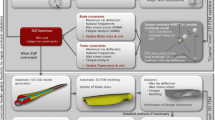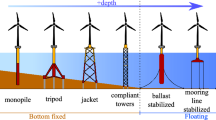Abstract
The article proposes an optimal design approach to minimize the mass of load carrying structures with discrete design variables. The design variables are chosen from catalogues, and several variables are assigned to each part of the structure. This allows for more design freedom than only choosing parts from a catalogue. The problems are modelled as mixed 0–1 nonlinear problems with nonconvex continuous relaxations. An algorithm based on outer approximation is proposed to find optimized designs. The capabilities of the approach are demonstrated by optimal design of a space frame (jacket) structure for offshore wind turbines, with requirements on natural frequencies, strength, and fatigue lifetime.




Similar content being viewed by others
Notes
This assumption is by no means critical for the optimal design approach in this article. It is commonly encountered for similar modelling situations in structural optimization e.g. for multi-material topology optimization Bendsøe and Sigmund (1999) and discrete material optimization, see e.g. Lund and Stegmann (2005) and Stegmann and Lund (2005).
This term refers to constraints which should be removed from the problem formulation if the corresponding part is not in the structure described by the current design variables.
Solve should, in this context, be interpreted as finding a point numerically satisfying the first-order optimality conditions.
The outer approximation property is generally not maintained for non-convex problems such as (P x ). The algorithm should therefore be considered as a heuristic.
References
Achtziger W, Kanzow C (2008) Mathematical programs with vanishing constraints: optimality conditions and constraint qualifications. Math Program 114:69–99
Achtziger W, Stolpe M (2007) Truss topology optimization with discrete design variables — guaranteed global optimality and benchmark examples. Struct Multidiscip Optim 34(1):1–20
Achtziger W, Stolpe M (2009) Global optimization of truss topology with discrete bar areas-Part II: implementation and numerical results. Comput Optim Appl 44(2):315–341
Amestoy PR, Duff IS, Koster J, L’Excellent J -Y (2001) A fully asynchronous multifrontal solver using distributed dynamic scheduling. SIAM J Matrix Anal Appl 23(1):15–41
Arora JS, Wang Q (2005) Review of formulations for structural and mechanical system optimization. Struct Multidiscip Optim 30(4):251–272
Arora JS, Huang MW, Hsieh CC (1994) Methods for optimization of nonlinear problems with discrete variables - a review. Struct Optim 8(2–3):69–85
ASTM (2013) Standard practices for cycle conting in fatigue analysis. Technical Report E1049, ASTM, https://compass.astm.org
Bak C, Zahle F, Bitsche R, Kim T, Yde A, Henriksen LC, Natarajan A, Hansen M (2013) The DTU 10 MW reference wind turbine. Technical report. DTU Wind Energy
Bendsøe MP, Sigmund O (1999) Material interpolation schemes in topology optimization. Arch Appl Mech 69(9–10):635–654
Bendsøe MP, Sigmund O (2003) Topology optimization, theory, methods and applications. Springer
Borstel T (2013) Design report - reference jacket. Technical Report D4.3.1, Ramboll. www.innwind.eu/publications/deliverable-reports, Accessed 13 Feb 2017
Cameron TM, Thirunavukarasu AC, El-Sayed MEM (2000) Optimization of frame structures with flexible joints. Struct Multidiscip Optim 19(3):204–213
Chang TC, Wysk RA (1997) Computer-aided manufacturing, 2nd edn. Prentice Hall PTR, Upper Saddle River
Chew KH, Tai K, Ng EYK, Muskulus M (2016) Analytical gradient-based optimization of offshore wind turbine substructures under fatigue and extreme loads. Mar Struct 47:23–41
Chin CM, Fletcher R (2003) On the global convergence of an SLP-filter algorithm that takes EQP steps. Math Program 96(1):161– 177
Christensen PW, Klarbring A (2008) An introduction to structural optimization. Solid mechanics and its applications. Springer, Netherlands
Cook RD, Malkus DS, Plesha ME, Witt RJ (2007) Concepts and applications of finite element analysis, 4th edn. Wiley
Damiani R (2016) JacketSE: an offshore wind turbine jacket sizing tool theory manual and sample usage with preliminary validation. Technical Report NREL/TP-5000-65417, National Renewable Energy Laboratory, NREL. www.nrel.gov/publications
Damiani R, Ning A, Maples B, Smith A, Dykes K (2017) Scenario analysis for techno-economic model development of U.S. offshore wind support structures. Wind Energy 20:731–747
DNVGL (2014) RP-C203 Fatigue design of offshore steel structures. Technical report DNVGL
Duran MA, Grossmann IE (1986) An outer-approximation algorithm for a class of mixed-integer nonlinear programs. Math Program 36(3):307–339
Faustino AM, Judice JJ, Ribeiro IA, Serra Neves A (2006) An integer programming model for truss topology optimization. Investigação Operacional 26:111–127
Fischer T, de Vries W, Schmidt B (2010) Upwind design basis technical report FP6 upwind report
Fletcher R, Leyffer S (1994) Solving mixed integer nonlinear programs by outer approximation. Math Program 66(1–3):327–349
Fredricson H, Johansen T, Klarbring A, Petersson J (2003) Topology optimization of frame structures with flexible joints. Struct Multidiscip Optim 25(3):199–214
Grossmann IE (2002) Review of nonlinear mixed-integer and disjunctive programming techniques. Optim Eng 3(3):227–252
IBM Corporation (2014) IBM ILOG CPLEX optimization studio V12.6.0 documentation. Technical report. IBM Corporation
Lund E, Stegmann J (2005) On structural optimization of composite shell structures using a discrete constitutive parametrization. Wind Energy 8(1):109–124
Martens JH, Zwick D, Muskulus M (2015) Topology optimization of a jacket structure for an offshore wind turbine with a genetic algorithm. In: 11th World Congress on structural and multidisciplinary optimization. Sydney
MathWorks Inc. (2016) MATLAB Primer. MathWorks Inc., R2016a edition. www.mathworks.com
Mela K (2014) Resolving issues with member buckling in truss topology optimization using a mixed variable approach. Struct Multidiscip Optim 50(6):1037–1049
Muñoz E, Stolpe M (2011) Generalized Benders’ decomposition for topology optimization problems. J Glob Optim 51(1):149–183
Muskulus M, Schafhirt S (2014) Design optimization of wind turbine support structures —a review. J Ocean Wind Energy 1(1):12–22
Oest J, Sørensen R, Overgaard LCT, Lund E (2017) Structural optimization with fatigue and ultimate limit constraints of jacket structures for large offshore wind turbines. Struct Multidiscip Optim 55(3):779–793
Pasamontes L, Torres FG, Zwick D, Schafhirt S, Muskulus M (2014) Support structure optimization for offshore wind. In: Proceedings of the ASME 2014 33rd international conference on ocean, offshore and arctic engineering. The American Society of Mechanical Engineers (ASME), San Francisco, pp 1–7
Pedersen CBW (2004) Crashworthiness design of transient frame structures using topology optimization. Comput Methods Appl Mech Eng 193(6-8):653–678
Pedersen P, Jørgensen L (1984) Minimum mass design of elastic frames subjected to multiple load cases. Comput Struct 18(1):147–157
Pedersen NL, Nielsen AK (2003) Optimization of practical trusses with constraints on eigenfrequencies, displacements, stresses, and buckling. Struct Multidiscip Optim 25(5–6):436–445
Rozvany GIN (1996) Difficulties in truss topology optimization with stress, local buckling and system stability constraints. Struct Optim 11:213–217
Rozvany GIN (2001) On design-dependent constraints and singular topologies. Struct Multidiscip Optim 21:164–172
Schafhirt S, Zwick D, Muskulus M (2014) Reanalysis of jacket support structure for computer-aided optimization of offshore wind turbines with a genetic algorithm. J Ocean Wind Energy 1(4):209–216
Seidel M, Voormeeren S, van der Steen JB (2016) State-of-the-art design processes for offshore wind turbine support structures. Stahlbau 85(9):583–590
Seyranian AP, Lund E, Olhoff N (1994) Multiple eigenvalues in structural optimization problems. Struct Optim 8(4):207–227
Stegmann J, Lund E (2005) Discrete material optimization of general composite shell structures. Int J Numer Methods Eng 62(14):2009–2027
Stolpe M (2007) On the reformulation of topology optimization problems as linear or convex quadratic mixed 0-1 programs. Optim Eng 8:163–192
Stolpe M (2014) Truss topology optimization with discrete design variables by outer approximation. J Glob Optim 61(1):139–163
Stolpe M, Svanberg K (2003) Modeling topology optimization problems as linear mixed 0–1 programs. Int J Numer Methods Eng 57(5):723–739
Svanberg K (1981) Optimization of geometry in truss design. Comput Methods Appl Mech Eng 28(1):63–80
Templeman AB (1988) Discrete optimum structural design. Comput Struct 30(3):511–518
Templeman AB, Yates DF (1983) A segmental method for the discrete optimum design of structures. Eng Optim 6(3):145–155
Wächter A, Biegler LT (2006) On the implementation of a primal-dual interior point filter line search algorithm for large-scale nonlinear programming. Math Program 106(1):25–57
Yates DF, Templeman AB, Boffey TB (1982) The complexity of procedures for determining minimum weight trusses with discrete member sizes. Int J Solids Struct 18(6):487–495
Zhu JH, Zhang WH, Xia L (2016) Topology optimization in aircraft and aerospace structures design. Arch Comput Methods Eng 23(4):595–622
Zwick D, Muskulus M, Moe G (2012) Iterative optimization approach for the design of full-height lattice towers for offshore wind turbines. Energy Procedia 24:297–304
Acknowledgements
The research presented in this manuscript is part of the strategic research project ABYSS: Advancing BeYond Shallow waterS - Optimal design of offshore wind turbine support structures (www.abyss.dk). The project is funded by the Danish Council for Strategic Research. The funding is gratefully acknowledged. The authors would like to thank the anonymous reviewers for valuable inputs to the final manuscript. In particular, the suggested benchmark with the genetic algorithm provided new insights to the performance of the presented optimization approach.
We would like to thank our colleague Alexander Verbart for his contributions to JADOP.
Author information
Authors and Affiliations
Corresponding author
Additional information
Responsible Editor: Anton Evgrafov
Publisher’s Note
Springer Nature remains neutral with regard to jurisdictional claims in published maps and institutional affiliations.
Rights and permissions
About this article
Cite this article
Stolpe, M., Sandal, K. Structural optimization with several discrete design variables per part by outer approximation. Struct Multidisc Optim 57, 2061–2073 (2018). https://doi.org/10.1007/s00158-018-1941-3
Received:
Revised:
Accepted:
Published:
Issue Date:
DOI: https://doi.org/10.1007/s00158-018-1941-3




